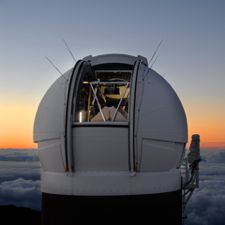
A new sentry is on guard atop the Haleakala volcano in Hawaii, scanning the skies for potentially threatening asteroids and comets. The first of four telescopes planned for the Pan-STARRS project, short for Panoramic Survey Telescope and Rapid Response System, began a dedicated survey of the sky May 13.
Pan-STARRS 1 (PS1) is a modest-size telescope, just 1.8 meters in diameter, but it has an extremely wide field of view, making it an ideal instrument for surveying. Its view encompasses seven square degrees at once - about 35 times the area of the full moon and more than four times as much sky as is visible to the telescope used in the influential Sloan Digital Sky Survey, which began in 2000. "In terms of survey power, we're the biggest telescope in the world," says PS1's director, Ken Chambers, an astronomer at the University of Hawaii's Institute for Astronomy (IfA). Pan-STARRS' operators predict that the telescope will complete a survey of the sky visible from Hawaii - about three quarters of the entire sky - three times a month.
With its large field of view, a 1.4-gigapixel digital camera, and a sophisticated data system that indexes hundreds of images a night and compares them to identify moving objects, Pan-STARRS 1 should help to finally retire the Congressionally mandated goal that NASA catalogue at least 90 percent of the estimated population of near-Earth objects (NEOs) larger than a kilometer. The original 2008 deadline for that task has passed, but the job is nearly done - current estimates peg the catalogued population at about 86 percent of the total number of kilometer-size asteroids that pass near Earth. None of the known near-Earth objects is projected to collide with Earth in the foreseeable future.
PS1 will also contribute to meeting a more ambitious Congressional goal - that NASA chart 90 percent of all asteroids larger than 140 meters by 2020. A 140-meter asteroid impact would not wipe out civilization but, with a wallop greater than the largest hydrogen bomb ever detonated, could bring serious regional destruction. Objects of that class may exceed 100,000 in number, and even a four-telescope Pan-STARRS would not be able to find 90 percent of them as soon as Congress has requested; notwithstanding the addition of other telescopes, the 2020 deadline will almost certainly pass without the goal being met.
"The beginning of Pan-STARRS operations is good news for the NEO community," says Donald Yeomans, manager of NASA's Near-Earth Object Program office. "It remains to be seen what the increased NEO discovery efficiency will be, but a perfectly healthy Pan-STARRS would have the capability to increase the NEO discovery rate severalfold over the current rate."
Just how soon Pan-STARRS will reach its planned four-telescope apex remains unclear, however. A January report on NEO detection and mitigation from the National Research Council in Washington, D.C., noted that most of the original funds allocated for the four-telescope system, known as PS4, went into building PS1, and that a funding source for the remaining three telescopes had not been identified. "Pan-STARRS will certainly make a contribution, but so far they only have PS1, and they don't have now even enough money to build PS2," says Michael A'Hearn of the University of Maryland, College Park, vice chair of the committee that produced the report. "To be a significant contributor, they need at least PS4."
PS2 is partially completed, says Nick Kaiser of IfA, the principal investigator for the Pan-STARRS project. He says that his group expects its next round of construction financing from the U.S. Air Force to come through soon and that PS4 should be complete within three to four years. "The funding for the project has been and continues to be year-by-year," Kaiser says. "So there's always some uncertainty there."
The arrival of another planned next-generation sky surveyor will help the NEO cause, but the 140-meter search appears to be a decades-long challenge. The Large Synoptic Sky Telescope (LSST), which is currently scheduled to begin observing in 2015 on Cerro Pachón in Chile, will boast several upgrades over Pan-STARRS, including a larger telescope, a wider field of view, and a 3.2-gigapixel camera. "LSST is clearly the big dog here, and promises to really clean up in reducing the inventory of hazardous asteroids," says astronomer Edward Beshore of the University of Arizona in Tucson, principal investigator for the asteroid-spotting Catalina Sky Survey project. But Beshore notes that with the LSST asteroid search sharing telescope time with other science programs, it will take 15 years from the LSST's start-up to satisfy the Congressional mandate for 140-meter objects.
Even though PS1 will not vault the NEO community over the 140-meter hurdle, it will make a dent in the problem and help to better characterize the threat. The telescope will also provide a new data set of things that go flash in the night sky by flagging objects that appear, disappear, brighten or fade between successive images. "One of the things that's novel about PS1 is its ability to achieve a whole wealth of science goals with the same data," Chambers says. Sampling the same areas of the sky as time passes will reveal transient supernovae and gamma-ray bursts, and Chambers predicts that the telescope will locate the most distant quasars yet. "It's intended to cover almost every area of astronomy," he says.



Comment: For our readers to get an idea of what lies ahead and what we truly need to worry about, read Laura Knight-Jadczyk's comprehensive SOTT editorial: Meteorites, Asteroids, and Comets: Damages, Disasters, Injuries, Deaths, and Very Close Calls